Perhaps, make this month a couples Valentine Sudoku puzzle and enjoy it together. Good idea?
|
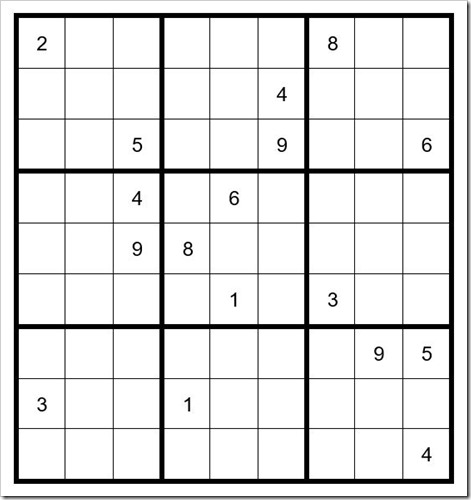
PUZZLE #34
|
|
DAN’S 8 STEP APPROACH TO SOLVING ALL SUDOKU PUZZLES
Once you have completed the puzzle, to the extent that you have filled-in all obvious answers and have written all potential options across the top of the unsolved cells (PUZZLE PREPARATION), Dan recommends the following Steps to complete the puzzle.
See TI Life Puzzle Preparation: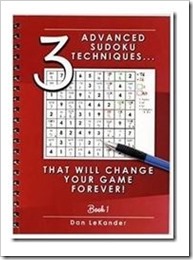
Step 1: Sudoku Pairs, Triplets and Quads – September 2015
Step 2: Turbos & Interaction – October 2015
Step 3: Sudoku Gordonian Rectangles and Polygons – November 2015
Step 4: XY-Wings & XYZ Wings – December 2015
Step 5: X-Wings – January 2016
________________
Step 6: DAN’S YES/NO CHALLENGE
Step 7: DAN’S CLOSE RELATIONSHIP CHALLENGE
Step 8: AN EXPANSION OF STEP 7
Steps 1-5 are relatively common techniques and are explained in the TI LIFE articles per above. Steps 6-8 are covered in detail, in Dan’s book.
Also, see Sudoku Puzzle Challenge… February 2016, March 2016, April 2016, May 2016, June 2016, July 2016, August 2016, September 2016, October 2016, November 2016, December 2016, January 2017, February 2017, March 2017 , April 2017, May 2017, June 2017, July 2017, August 2017, September 2017, October 2017 , November 2017 , December 2017 and January 2018.
As a reminder, the basic rules of Sudoku are that the numbers 1-9 must be contained and cannot be repeated in a row, column, or box, and there can only be one solution to the puzzle.
|
PUZZLE PREPARATION
Prior to utilizing techniques first complete the 4 Steps of Puzzle Preparation …
- FILL IN OBVIOUS ANSWERS
- FILL IN NOT-SO-OBVIOUS ANSWERS
- MARK UNSOLVED CELLS WITH OPTIONS THAT CANNOT EXIST IN THOSE CELLS
- FILL IN THE OPTIONS FOR THE UNSOLVED CELLS
OBVIOUS ANSWERS …
Start with the 1’s to see if there are any obvious 1-choice answers. Then navigate the 2’s through 9’s.
The first obvious answer is C6R1=1 (cell in column 6, row 1). C8R9=3.
NOT-SO-OBVIOUS ANSWERS …
There are none.
NUMBERS IN CELLS THAT CANNOT EXIST …
In box 9 (lower right-hand box of 3X3 cells) a 1 can only exist in C7R7 or C7R9; therefore, a 1 cannot exist in C7R2, C7R3, C7R4 or C7R5. Mark a small “1” in pencil in the bottom of those two cells to indicate they cannot be a 1, in preparation for the next step.
In box 4, a 3 can only exist in C2R4 or C2R5; therefore, a 3 cannot exist in C4R7 or C4R9.
In box 2, a 6 can only exist in C4R1, C4R2 or C4R3; therefore, a 6 cannot exist in C4R7 or C4R9.
In box 2, an 8 can only exist in C5R2 or C5R3; therefore, an 8 cannot exist in C5R7, C5R8 or C5R9.
In box 9, an 8 can only exist in C8R8 or C9R8; therefore an 8 cannot exist in any other unsolved cell in row 8.
In box 5, a 9 can only exist in C4R4 or C4R6; therefore, a 9 cannot exist in C4R9.
Now your grid should look like Example #34.1 below:
|
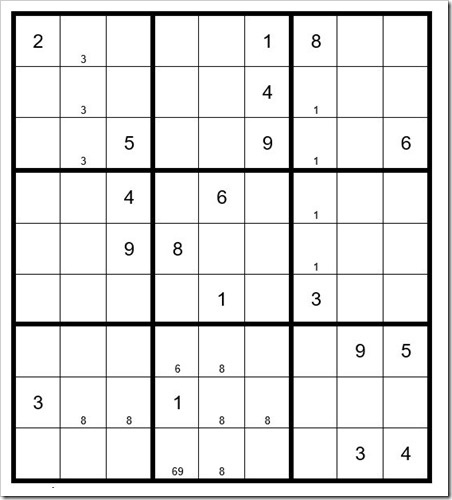
Example #34.1
|
FILL IN THE OPTIONS FOR THE UNSOLVED CELLS …
Now your grid should look like Example #34.2 below:
|
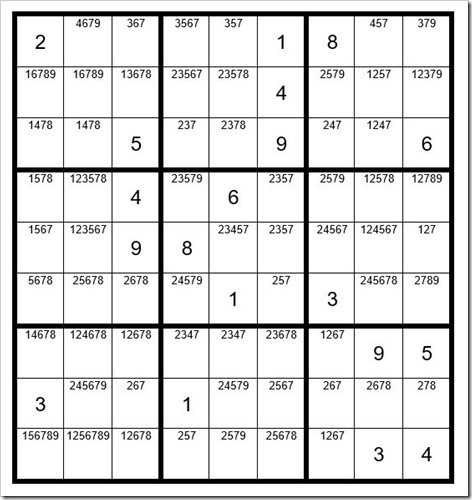
Example #34.2
|
STEPS 1-5
STEP 1: PAIRS, TRIPLETS, QUADS
Search each row, column & box. Do you spot any Step 1 clues?
Ok, can you find an obvious pair, triplet or quad?
Ok, check our row 8. What clue do you find?
Right, there are 4 unsolved cells that contain only some or all of the 4 options 2678. This is an “Obvious Quad”. Looks like cells C3R8, C7R8, C8R8 & C9R8 have a monopoly on the options 2678; therefore, no other cell in row 8 may have the options 2678. After removing these options from C2R8, C5R8 & C6R8 you find that C6R8 now only has the one option. C6R8=5. Now your grid should look like Example #34.3 below:
|
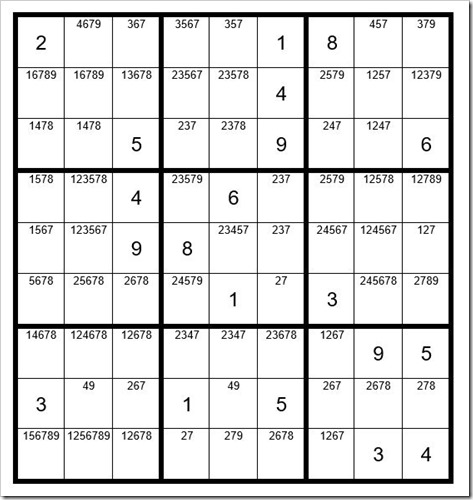
Example #34.3
|
Now ask yourself if the 5 in C6R8 has produced any new clues? Yes, look at C6R4, C6R5 & C6R6. There are 3 cells that have only 3 options (237), which is an Obvious Triplet. No other cells in column 6 or box 5 may contain options 2, 3 or 7. Now your grid should look like Example #34.4 below:
|
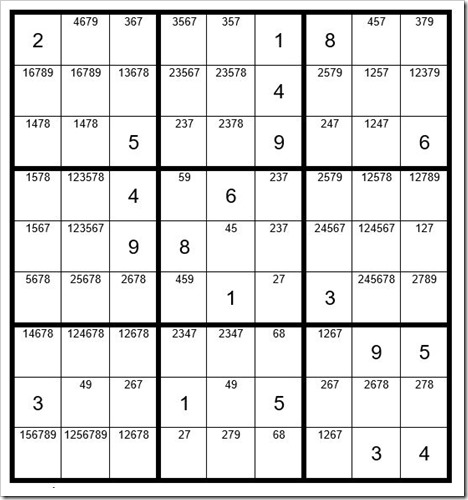
Example #34.4
|
Now we will move on to Step 2.
STEP 2: INTERACTIONS & TURBOS
What do you notice about row 3? The only 2 cells in that row that can be a 3, are C4R3 & C5R3. So, can any other cell in box 2 have a 3 as an option? No! You may now delete the 3 as an option from C3R1, C4R1, C3R2 & C4R2. Now your grid should look like Example #34.5 below:
|
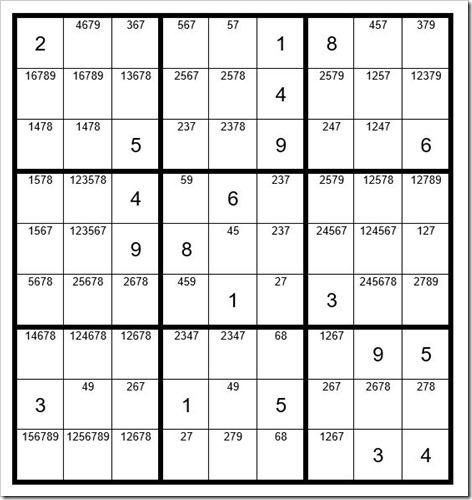
Example #34.5
|
There are no other Step 1-5 clues, so we will move on to Step 6.
STEP 6: DAN’S YES-NO CHALLENGE
There are 3 circumstances that establish the potential for a Step 6 exercise:
- Look for just 2 unsolved cells in a box that contain the same option where these 2 cells are not in the same row or column.
- Look for just 2 unsolved cells in a column that contain the same option where these 2 cells are not in the same box.
- Look for just 2 unsolved cells in a row that contain the same option where these 2 cells are not in the same box.
In row 1 we find just 2 unsolved cells that contain the option 4 … C1R3 & C1R7. These cells are not in the same box, thereby qualifying as a candidate for a Step 6 exercise. These cells are highlighted in yellow in Example #34.6 below:
|
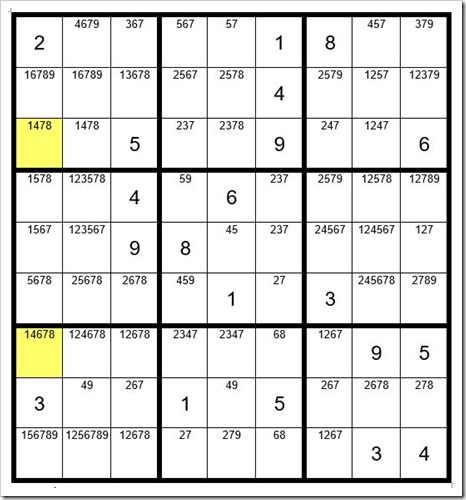
Example #34.6
|
One of these two yellow cells must be a 4. We will consider them as “driver cells” which “drive” the exercise.
Here is the logic. We will perform two exercises. First, we will assume C1R3 is the 4, and see which other cells cannot be a 4. Then we will assume C1R7 is the 4, and see which other cells cannot be a 4. What happens if we find a cell or cells that cannot be a 4 regardless of which cell in column 1 is a 4? Quite simply, it means that that cell cannot be a 4 and you can eliminate the 4 from that cell or those cells.
We will mark C1R3 with a “Y” and mark C1R7 with a lower case “y” to keep track of the exercise as per Example #34.7 below.
If C1R3=4 (marked with a Y), then C7R3 and C8R3 cannot be a 4 and we mark them below with a “N” for no. The only other choice for a 4 is C8R1 and we will mark it with a Y. Then C8R5=N & C8R6=N. Then C7R5=Y. Then C5R5=N. Then C4R6=Y and C4R7=N.
If C1R7=4 (marked as a y), then C4R7=n and C5R7=n. Then C5R8=y. Then C5R5=n. Then C4R6=y. Then C8R6=n.
Let’s evaluate the situation. One of the yellow cells must be a 4. However, we find 3 cells (marked with a N,n) that are not a 4 regardless of which yellow cell is a 4. We can therefore eliminate the 4 as an option from these 3 cells. But also check out C4R6! It is a 4 regardless of which yellow cell is a 4. C4R6=4. Then C5R5=5. C5R1=7. C4R4=9.
|
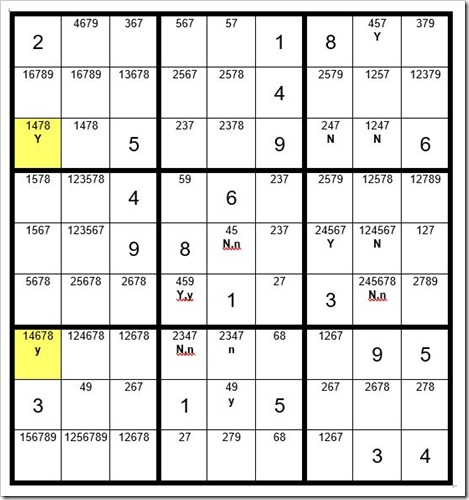
Example #34.7
|
Now your grid should look like Example #34.8 below:
|
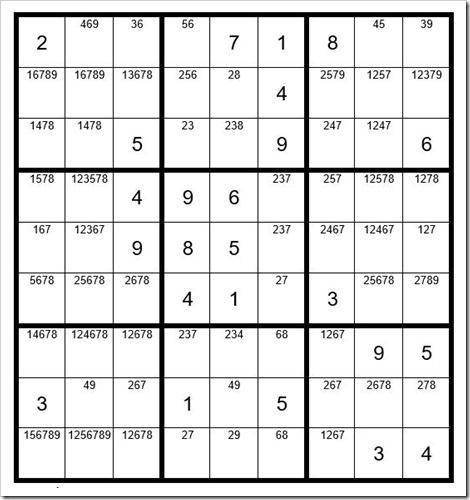
Example #34.8
|
Well, that was helpful. So where do we go from here? Did the Step 6 results provide any other clues?
First of all, check out box 6. The only cell that can be a 9 is C9R6. C9R6=9. Then C9R1=3. C3R1=6. “Easy pickins” from here.
Your finished grid should look like Example #34.9 below:
|
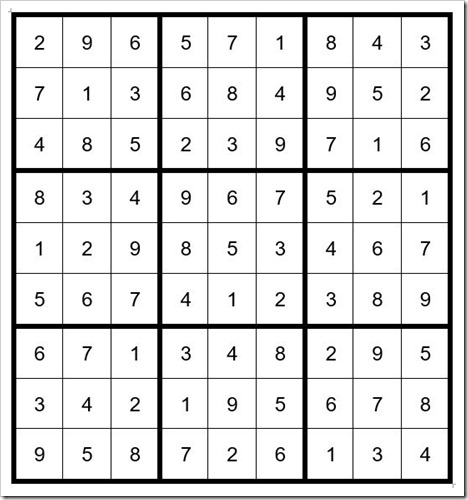
Example #34.9
|
Step 6 has a tendency to bring difficult Sudoku puzzles to submission, time and time again. It is an exercise of looking past the complexity of a problem and instead, focusing on a subtle aspect of what can and cannot be. I sincerely hope you appreciate this exercise as it took a considerable amount of time to develop and to understand the intricacies of its influence on a puzzle.
May the gentle winds of Sudoku be at your back.
Editor’s note:
Do you tackle a Sudoku on your cottage veranda, sailboat cockpit, or at a campsite? And now in February… how about the beach!
TI Life is taking full advantage of Dan LeKander, from Wellesley Island, who is a Sudoku expert and author of “3 Advanced Sudoku Techniques – That Will Change Your Game Forever!”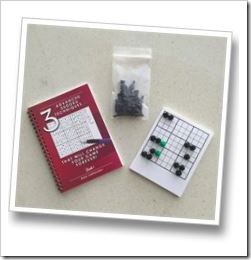
In January 2016, we published a final article in his series – but many of us enjoy using “Dan’s Steps,” so when he asked if we would like a puzzle to solve every month … this editor said an enthusiastic… Yes, please! Now we are two years later and on Puzzle #34!
I suggest you purchase Dan’s book, “3 Advanced Sudoku Techniques, That Will Change Your Game Forever!”
Dan’s book is available online, amazon.com and on ebay.com.
Purchase of a book includes a 50-page blank grid pad, 33 black and two green tokens, to assist with Step 6.…
Most importantly, I ask that you leave comments on any part of his series and throughout the year. Remember when your teacher said – no such thing as a silly question – as we can all learn together.
As always, I want to thank Dan…and his proof reader… Peggy! what a lot of work they put into our TI Life articles.
|
By Dan LeKander, Wellesley Island
Dan LeKander and his wife, Peggy, have been seasonal residents of Fineview, on Wellesley Island, NY, since 1983. In addition to being a Sudoku addict, Dan explores the 1000 Islands to enjoy the wildlife, beauty and of course, Catch-and Release bass fishing.
Editor’s Note: Wow; Number 34! How many have you completed?
[See Jessy Kahn’s Book Review, “3 Advanced Sudoku Techniques…” by Dan LeKander, June issue of TI Life.]